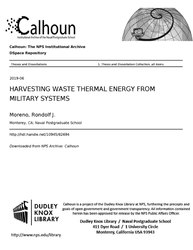File:HARVESTING WASTE THERMAL ENERGY FROM MILITARY SYSTEMS (IA harvestingwastet1094562694).pdf

Original file (1,275 × 1,650 pixels, file size: 1.73 MB, MIME type: application/pdf, 70 pages)
Captions
Captions
Summary[edit]
| HARVESTING WASTE THERMAL ENERGY FROM MILITARY SYSTEMS
( |
||
|---|---|---|
| Author |
Moreno, Rondolf J. |
|
| Title |
HARVESTING WASTE THERMAL ENERGY FROM MILITARY SYSTEMS |
|
| Publisher |
Monterey, CA; Naval Postgraduate School |
|
| Description |
Military systems greatly depend on the availability of energy. This energy comes mostly in the form of burning fuel in order to produce mechanical work or electricity. The ability to extract the most out of these systems aligns with the current focus of energy efficiency, not only in the military but also in society at-large. This research used a commercial thermoelectric generator (TEG) to produce an output baseline for the technology. Using an apparatus to produce heat and analyze the output, calculations performed produced correlation coefficients. These coefficients modeled a virtual TEG in COMSOL and yielded 0.72W of power. A simple design using simple calculations yielded 72W of power with 100 modules joined in 10 sets coupled in parallel, with each set containing 10 modules in coupled in series. More robust modeling and simulation design further created models that refine the design process when creating a TEG array. By building these robust design models, a systems engineer would better understand the trade space when applying this technology to a system. Additionally, the models presented in this paper can form the basis by which to explore the application of TEGs on systems. As TEGs passively convert thermal energy into electricity, a possible intrinsic benefit appears. The thermal energy converted would reduce the thermal signature of the system. Subjects: thermal signature; energy; energy recovery bismuth telluride; energy conversion; heat transfer; heat recovery; thermal conductivity; thermal; thermal power; modeling; thermoelectric; thermoelectric generator; simulation; Seebeck effect |
|
| Language | English | |
| Publication date | June 2019 | |
| Current location |
IA Collections: navalpostgraduateschoollibrary; fedlink |
|
| Accession number |
harvestingwastet1094562694 |
|
| Source | ||
| Permission (Reusing this file) |
This publication is a work of the U.S. Government as defined in Title 17, United States Code, Section 101. Copyright protection is not available for this work in the United States. | |
Licensing[edit]
| Public domainPublic domainfalsefalse |
This work is in the public domain in the United States because it is a work prepared by an officer or employee of the United States Government as part of that person’s official duties under the terms of Title 17, Chapter 1, Section 105 of the US Code.
Note: This only applies to original works of the Federal Government and not to the work of any individual U.S. state, territory, commonwealth, county, municipality, or any other subdivision. This template also does not apply to postage stamp designs published by the United States Postal Service since 1978. (See § 313.6(C)(1) of Compendium of U.S. Copyright Office Practices). It also does not apply to certain US coins; see The US Mint Terms of Use.
|
 | |
| This file has been identified as being free of known restrictions under copyright law, including all related and neighboring rights. | ||
https://creativecommons.org/publicdomain/mark/1.0/PDMCreative Commons Public Domain Mark 1.0falsefalse
File history
Click on a date/time to view the file as it appeared at that time.
| Date/Time | Thumbnail | Dimensions | User | Comment | |
|---|---|---|---|---|---|
| current | 17:17, 21 July 2020 |  | 1,275 × 1,650, 70 pages (1.73 MB) | Fæ (talk | contribs) | FEDLINK - United States Federal Collection harvestingwastet1094562694 (User talk:Fæ/IA books#Fork8) (batch 1993-2020 #17558) |
You cannot overwrite this file.
File usage on Commons
The following page uses this file:
Metadata
This file contains additional information such as Exif metadata which may have been added by the digital camera, scanner, or software program used to create or digitize it. If the file has been modified from its original state, some details such as the timestamp may not fully reflect those of the original file. The timestamp is only as accurate as the clock in the camera, and it may be completely wrong.
| Short title | HARVESTING WASTE THERMAL ENERGY FROM MILITARY SYSTEMS |
|---|---|
| Image title | |
| Author | Moreno, Rondolf J. |
| Software used | Moreno, Rondolf J. |
| Conversion program | Adobe PDF Library 11.0 |
| Encrypted | no |
| Page size | 612 x 792 pts (letter) |
| Version of PDF format | 1.4 |

